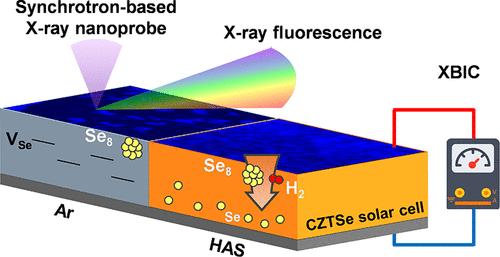当前位置:
X-MOL 学术
›
ACS Appl. Mater. Interfaces
›
论文详情
Our official English website, www.x-mol.net, welcomes your
feedback! (Note: you will need to create a separate account there.)
Visualization of Anion Vacancy Defect Annihilation in CZTSe Solar Cells by Hydrogen-Assisted Selenization with In Operando X-ray Nanoprobe Studies
ACS Applied Materials & Interfaces ( IF 8.3 ) Pub Date : 2024-11-15 , DOI: 10.1021/acsami.4c11127 Chih-Yang Huang, Shao-Chin Tseng, Wei-Chao Chen, Gung-Chian Yin, Bo-Yi Chen, Kuei-Hsien Chen, Li-Chyong Chen, Cheng-Ying Chen
ACS Applied Materials & Interfaces ( IF 8.3 ) Pub Date : 2024-11-15 , DOI: 10.1021/acsami.4c11127 Chih-Yang Huang, Shao-Chin Tseng, Wei-Chao Chen, Gung-Chian Yin, Bo-Yi Chen, Kuei-Hsien Chen, Li-Chyong Chen, Cheng-Ying Chen

|
The traditional sulfur selenization process in Cu2ZnSn(S,Se)4 (CZTSSe) solar cell fabrication often results in the creation of localized anion vacancies (VS and VSe). These vacancies are considered harmful defects as they can trap carriers generated by light, leading to reduced solar cell efficiency. Moreover, concrete evidence has been lacking on the extent of the impact caused by these anion vacancies. Our research introduces a novel approach: the hydrogen-assisted selenization (HAS) process, specifically designed to minimize localized anion vacancies in Cu2ZnSnSe4 (CZTSe) solar cells. Our investigation, utilizing current–voltage (I–V) and admittance spectroscopy measurements, provides clear insights. We observed notable improvements in carrier collection efficiency and a discernible reduction in defect states. Furthermore, there was a significant decrease in the activation energy required within the solar cell device, dropping from 184 to 145 meV. To delve deeper into the structural and compositional aspects, we employed synchrotron-based X-ray nanoprobes. Through nanoscale X-ray fluorescence and hard X-ray beam-induced current measurements, we can directly observe and document the relationship between the local compositional distribution and photocurrent activity in operando. These comprehensive results furnish strong evidence that mitigating anion vacancies in the CZTSe layer can substantially improve the power conversion efficiency of the CZTSe solar cells. This advancement not only sheds light on the critical role of anion vacancies in solar cell performance but also underscores the effectiveness of the HAS process in enhancing overall device efficiency.
中文翻译:

通过氢辅助硒化和原位 X 射线纳米探针研究对 CZTSe 太阳能电池中阴离子空位缺陷湮灭的可视化
Cu2ZnSn(S,Se)4 (CZTSSe) 太阳能电池制造中的传统硫硒化过程通常会导致产生局部阴离子空位(VS 和 VSe)。这些空位被认为是有害缺陷,因为它们可以捕获光产生的载流子,导致太阳能电池效率降低。此外,关于这些阴离子空位造成的影响程度,一直缺乏具体证据。我们的研究引入了一种新方法:氢辅助硒化 (HAS) 工艺,专门设计用于最大限度地减少 Cu2ZnSnSe4 (CZTSe) 太阳能电池中的局部阴离子空位。我们的研究利用电流-电压 (I-V) 和导纳光谱测量,提供了清晰的见解。我们观察到运营商收集效率的显著提高,缺陷状态明显减少。此外,太阳能电池装置内所需的活化能显着降低,从 184 meV 降至 145 meV。为了更深入地研究结构和组成方面,我们采用了基于同步加速器的 X 射线纳米探针。通过纳米级 X 射线荧光和硬 X 射线束感应电流测量,我们可以直接观察和记录局部成分分布与光电流活动之间的关系。这些综合结果提供了强有力的证据,表明减少 CZTSe 层中的阴离子空位可以显着提高 CZTSe 太阳能电池的功率转换效率。 这一进步不仅揭示了阴离子空位在太阳能电池性能中的关键作用,还强调了 HAS 工艺在提高整体器件效率方面的有效性。
更新日期:2024-11-15
中文翻译:

通过氢辅助硒化和原位 X 射线纳米探针研究对 CZTSe 太阳能电池中阴离子空位缺陷湮灭的可视化
Cu2ZnSn(S,Se)4 (CZTSSe) 太阳能电池制造中的传统硫硒化过程通常会导致产生局部阴离子空位(VS 和 VSe)。这些空位被认为是有害缺陷,因为它们可以捕获光产生的载流子,导致太阳能电池效率降低。此外,关于这些阴离子空位造成的影响程度,一直缺乏具体证据。我们的研究引入了一种新方法:氢辅助硒化 (HAS) 工艺,专门设计用于最大限度地减少 Cu2ZnSnSe4 (CZTSe) 太阳能电池中的局部阴离子空位。我们的研究利用电流-电压 (I-V) 和导纳光谱测量,提供了清晰的见解。我们观察到运营商收集效率的显著提高,缺陷状态明显减少。此外,太阳能电池装置内所需的活化能显着降低,从 184 meV 降至 145 meV。为了更深入地研究结构和组成方面,我们采用了基于同步加速器的 X 射线纳米探针。通过纳米级 X 射线荧光和硬 X 射线束感应电流测量,我们可以直接观察和记录局部成分分布与光电流活动之间的关系。这些综合结果提供了强有力的证据,表明减少 CZTSe 层中的阴离子空位可以显着提高 CZTSe 太阳能电池的功率转换效率。 这一进步不仅揭示了阴离子空位在太阳能电池性能中的关键作用,还强调了 HAS 工艺在提高整体器件效率方面的有效性。

































 京公网安备 11010802027423号
京公网安备 11010802027423号